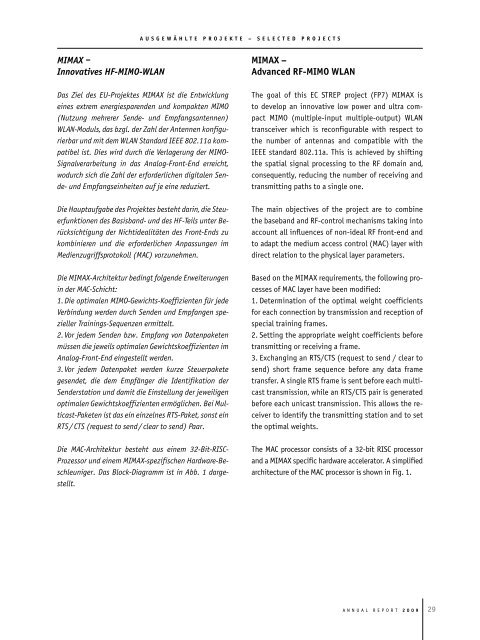Deliverables and Services - IHP Microelectronics
Deliverables and Services - IHP Microelectronics
Deliverables and Services - IHP Microelectronics
Create successful ePaper yourself
Turn your PDF publications into a flip-book with our unique Google optimized e-Paper software.
MIMAX –<br />
Innovatives HF-MIMO-WLAN<br />
A u S G e w ä H L t e p r o J e K t e – S e L e C t e d p r o J e C t S<br />
Das Ziel des EU-Projektes MIMAX ist die Entwicklung<br />
eines extrem energiesparenden und kompakten MIMO<br />
(Nutzung mehrerer Sende- und Empfangsantennen)<br />
WLAN-Moduls, das bzgl. der Zahl der Antennen konfigurierbar<br />
und mit dem WLAN St<strong>and</strong>ard IEEE 802.11a kompatibel<br />
ist. Dies wird durch die Verlagerung der MIMO-<br />
Signalverarbeitung in das Analog-Front-End erreicht,<br />
wodurch sich die Zahl der erforderlichen digitalen Sende-<br />
und Empfangseinheiten auf je eine reduziert.<br />
Die Hauptaufgabe des Projektes besteht darin, die Steuerfunktionen<br />
des Basisb<strong>and</strong>- und des HF-Teils unter Berücksichtigung<br />
der Nichtidealitäten des Front-Ends zu<br />
kombinieren und die erforderlichen Anpassungen im<br />
Medienzugriffsprotokoll (MAC) vorzunehmen.<br />
Die MIMAX-Architektur bedingt folgende Erweiterungen<br />
in der MAC-Schicht:<br />
1. Die optimalen MIMO-Gewichts-Koeffizienten für jede<br />
Verbindung werden durch Senden und Empfangen spezieller<br />
Trainings-Sequenzen ermittelt.<br />
2. Vor jedem Senden bzw. Empfang von Datenpaketen<br />
müssen die jeweils optimalen Gewichtskoeffizienten im<br />
Analog-Front-End eingestellt werden.<br />
3. Vor jedem Datenpaket werden kurze Steuerpakete<br />
gesendet, die dem Empfänger die Identifikation der<br />
Senderstation und damit die Einstellung der jeweiligen<br />
optimalen Gewichtskoeffizienten ermöglichen. Bei Multicast-Paketen<br />
ist das ein einzelnes RTS-Paket, sonst ein<br />
RTS / CTS (request to send / clear to send) Paar.<br />
Die MAC-Architektur besteht aus einem 32-Bit-RISC-<br />
Prozessor und einem MIMAX-spezifischen Hardware-Beschleuniger.<br />
Das Block-Diagramm ist in Abb. 1 dargestellt.<br />
MIMAX –<br />
Advanced rF-MIMo wLAN<br />
the goal of this eC StRep project (Fp7) MIMAX is<br />
to develop an innovative low power <strong>and</strong> ultra compact<br />
MIMo (multiple-input multiple-output) WlAn<br />
transceiver which is reconfigurable with respect to<br />
the number of antennas <strong>and</strong> compatible with the<br />
Ieee st<strong>and</strong>ard 802.11a. this is achieved by shifting<br />
the spatial signal processing to the RF domain <strong>and</strong>,<br />
consequently, reducing the number of receiving <strong>and</strong><br />
transmitting paths to a single one.<br />
the main objectives of the project are to combine<br />
the baseb<strong>and</strong> <strong>and</strong> RF-control mechanisms taking into<br />
account all influences of non-ideal RF front-end <strong>and</strong><br />
to adapt the medium access control (MAC) layer with<br />
direct relation to the physical layer parameters.<br />
Based on the MIMAX requirements, the following processes<br />
of MAC layer have been modified:<br />
1. Determination of the optimal weight coefficients<br />
for each connection by transmission <strong>and</strong> reception of<br />
special training frames.<br />
2. Setting the appropriate weight coefficients before<br />
transmitting or receiving a frame.<br />
3. exchanging an RtS/CtS (request to send / clear to<br />
send) short frame sequence before any data frame<br />
transfer. A single RtS frame is sent before each multicast<br />
transmission, while an RtS/CtS pair is generated<br />
before each unicast transmission. this allows the receiver<br />
to identify the transmitting station <strong>and</strong> to set<br />
the optimal weights.<br />
the MAC processor consists of a 32-bit RISC processor<br />
<strong>and</strong> a MIMAX specific hardware accelerator. A simplified<br />
architecture of the MAC processor is shown in Fig. 1.<br />
A n n u A l R e p o R t 2 0 0 9<br />
29










